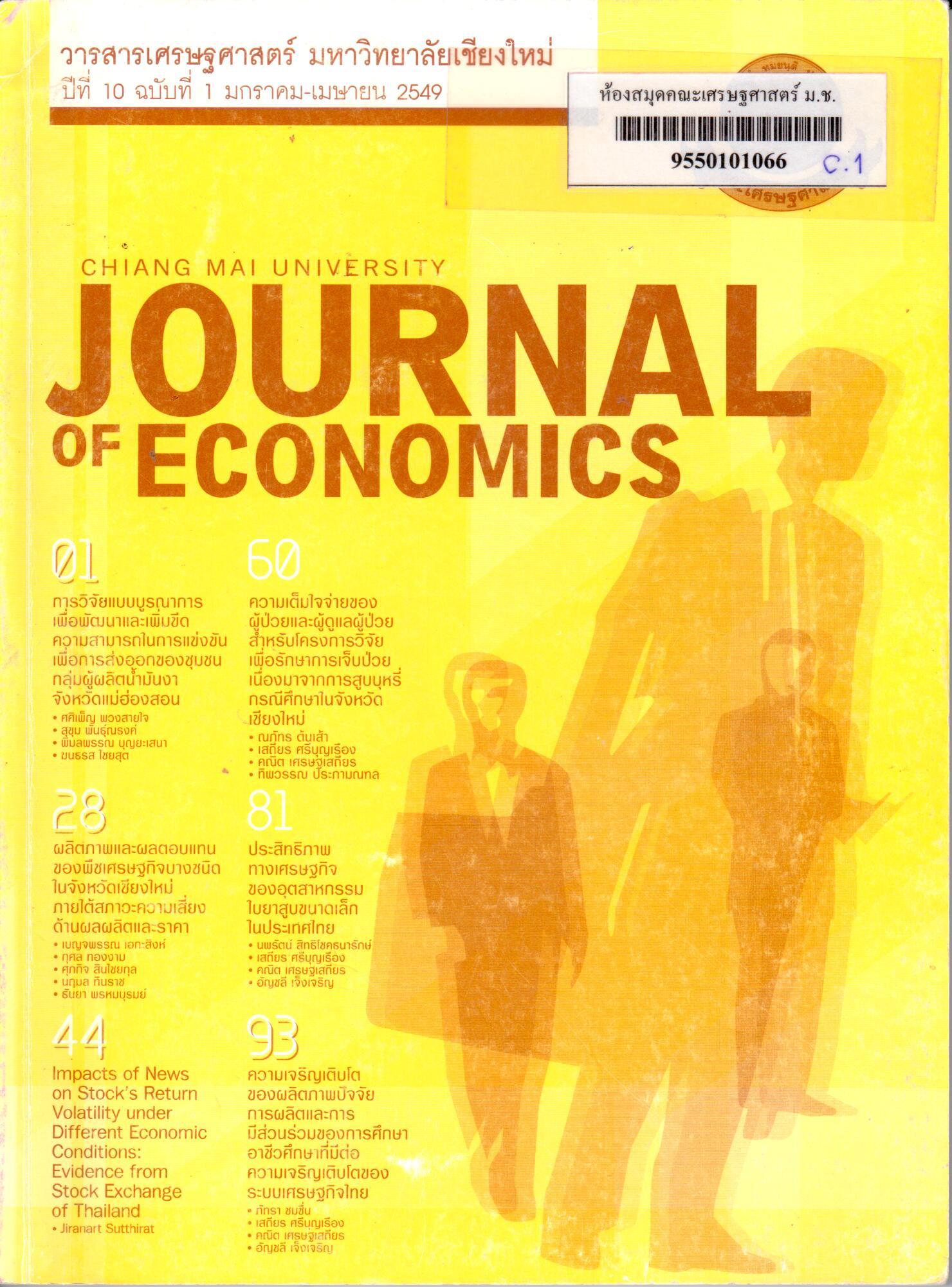การวิเคราะห์ ความต้องการสินเชื่อเพื่อการศึกษาของนักศึกษามหาวิทยาลัยเทคโนโลยีราชมงคลล้านนา เชียงใหม่ ปีการศึกษา 2547
Abstract
บทคัดย่อ
วัตถุประสงค์หลักของการศึกษาครั้งนี้ คือเพื่อศึกษาสภาพเศรษฐกิจและสังคม ภาระค่าใช้จ่าย ปริมาณความต้องการสินเชื่อเพื่อการศึกษาและวิเคราะห์ปัจจัยที่มีอิทธิพลต่อความต้องการสินเชื่อเพื่อการศึกษาของนักศึกษามหาวิทยาลัยเทคโนโลยีล้านนาราชมงคล เชียงใหม่ ปีการศึกษา 2547 จำนวนตัวอย่างรวม 1256 ราย โดยแบ่งออกเป็น 6 กลุ่ม (2 ระดับการศึกษา) คือ นักศึกษาระดับประกาศนียบัตรวิชาชีพขั้นสูง (ปวส.) รวมทุกแผนก/คณะวิชา ปริญญาตรีรวมทุกสาขาวิชา/คณะปริญญาตรีรวมเฉพาะคณะบริหารธุรกิจกับศิลปศาสตร์ (การท่องเที่ยว 4 ปี) ปริญญาตรีครุศาสตร์อุตสาหกรรม ปริญญาตรีวิศวกรรมศาสตร์ และปริญญาตรีรวมเฉพาะคณะสถาปัตยกรรมศาสตร์กับศิลปกรรมศาสตร์ และเทคโนโลยีสื่อสารมวลชน
ผลการศึกษาด้านสภาพเศรษฐกิจและสังคมพบว่า บิดา-มารดา ของนักศึกษา ส่วนใหญ่ของ 65.80% ประกอบอาชีพ รับจ้าง เกษตรกรรม ค้าขาย รายได้รวมของครอบครัวเฉลี่ยอยู่ระหว่าง 11,792.64 - 15,734.45 บาท/เดือน ในขณะที่ค่าใช้จ่ายรวมเฉลี่ยของนักศึกษาอยู่ระหว่าง 7,734.84 - 8,100.31 บาท/เดือน นักศึกษามีความต้องการสินเชื่อเพียง 46.74% ของผู้มีของผู้ใช้สินเชื่อรวม 47.53%
ผลการวิเคราะห์ปัจจัยที่มีผลต่อความต้องการสินเชื่อเพื่อการศึกษาเพราะว่า ตัวแปรอธิบายทั้งหมดส่วนใหญ่ ยกเว้น อัตราดอกเบี้ย,รายได้ที่คาดว่าจะได้รับหลังจบการศึกษา มีทิศทางของความสัมพันธ์กับความต้องการสินเชื่อเพื่อการศึกษาเป็นไปตามสมมติฐาน ตัวแปรที่สามารถอธิบายการเปลี่ยนแปลงค่าความน่าจะเป็นที่ตัวอย่างจะมีความต้องการสินเชื่อเพื่อการศึกษาได้อย่างมีนัยสำคัญทางสถิติ ณ ระดับความเชื่อมั่น 99% ได้แก่ อัตราดอกเบี้ย ระยะเวลาในการชำระคืนเงินกู้ ระยะเวลาปลอดหนี้ และค่าใช้จ่ายส่วนตัวรวมของนักศึกษา
ผลจากการพยากรณ์ปริมาณความต้องการสินเชื่อเพื่อการศึกษา พบว่า นักศึกษากลุ่มที่ 1 มีความต้องการสินเชื่อจำนวน 85,734.52 บาท/คน/ปี และ 5 กลุ่มที่เหลือ มีความต้องการสินเชื่อจำนวน 88,152.63, 84,383.63, 77,036.32, 100,762.20 และ 100,979.93 บาท/คน/ปีตามลำดับ
Abstract
The main purpose of this study was to investigate social and economic situation, expenditures, needs for study loan, as well as problems and solutions of the students , to analysis factors influencing student loans demand and to estimate student loans demand and to estimate student loans demand in Rajamangala University of Technology Lanna (chiangmai) in the academic year of 2004.
The groups studies were divided into six groups according to their educational levels, that is, one group of diploma level students. These included 1,256 samples.
The result of the study regarding social and economic situation as well as total expenditure of the students revealed that most of the respondents were female. Their parents were workers, farmers and merchants. This was 65.80% overall. The average family’s income was between 11,792.64 – 15,734.45 baht monthly. Students’ internal and external average income per month was between 4,722.06 – 6,403.77 baht. Those from diploma level obtained their internal income the most, while those from degree level obtained it from external resources. Their monthly average expenditure was between 7,734.84 – 8,100.31 baht, most of which were routine expenses. 46.74% of the samples needed a study loan. Their important reasons were inadequate income and a need to help their parents. It was recommended that the institute support them by providing scholarships and part-time jobs. 47.53% were on study loans.
The research forecast that diploma students would need a study loan of 84,249.45 baht/person/year. The five groups of degree level above required the following amounts respectively 88,152.63 baht/person/year, 84,383.63 baht/person/year, 77,036.32 baht/person/year, 100,762.20 baht/person/year and 100,979.93 baht/person/year.
Downloads
Issue
Section
License
All opinions and contents in the CMJE are the responsibility of the author(s). Chiang Mai University Journal of Economics reserves the copyright for all published materials. Papers may not be reproduced in any form without the written permission from Chiang Mai University Journal of Economics.
ข้อคิดเห็นที่ปรากฏและแสดงในเนื้อหาบทความต่างๆในวารสารเศรษฐศาสตร์มหาวิทยาลัยเชียงใหม่ ถือเป็นความเห็นและความรับผิดชอบโดยตรงของผู้เขียนบทความนั้นๆ มิใช่เป็นความเห็นและความรับผิดชอบใดๆของวารสารเศรษฐศาสตร์ มหาวิทยาลัยเชียงใหม่
บทความ เนื้อหา และข้อมูล ฯลฯ ในวารสารเศรษฐศาสตร์มหาวิทยาลัยเชียงใหม่ ถือเป็นลิขสิทธิ์เฉพาะของคณะเศรษฐศาสตร์มหาวิทยาลัยเชียงใหม่ หากบุคคลหรือหน่วยงานใดต้องการนำทั้งหมดหรือส่วนหนึ่งส่วนใดไปเผยแพร่ต่อหรือเพื่อกระทำการใดๆ จะต้องได้รับอนุญาตเป็นลายลักษณ์อักษร จากวารสารเศรษฐศาสตร์ มหาวิทยาลัยเชียงใหม่






